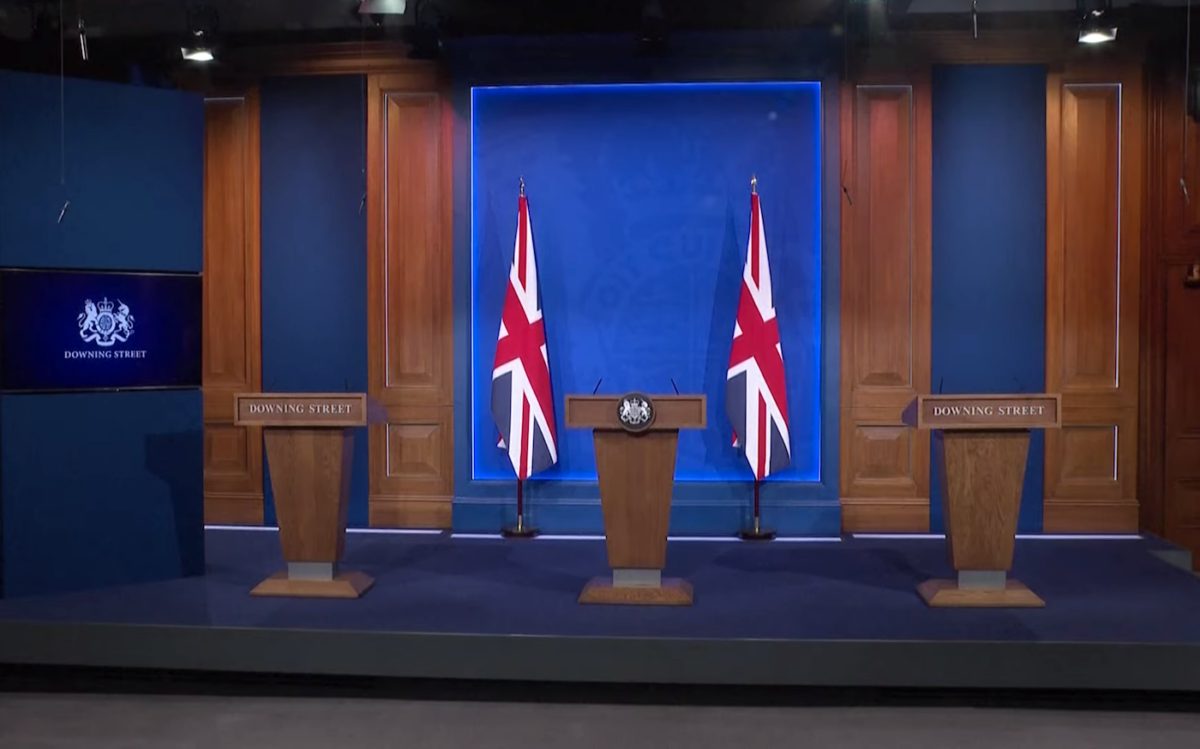At a cost of £2.6m, the UK government’s new White House-style press briefing room is surely nothing more than an ill-timed vanity project

Words by Matthew Ponsford
The first thing that hits you about Boris Johnson’s new briefing room is the huge flags. Johnson is bang-average 5’9 (with a habit of telling people he’s 5’10). But these Union Jacks tower above him, each one probably a 6ft flag on an 8ft pole. When he emerged for the first announcement from the new briefing room at 9 Downing Street on Monday 29 March, he looked like a child playing prime minister on an adult’s stage, which probably wasn’t the idea.
When the first pictures emerged of the briefing room earlier in March, you couldn’t quite gauge the scale of those hefty flags (although, initially, there were four of them). The first jokes took aim at the overall naffness of the place, the oak panelling suspended haphazardly between blue screens, and the unsubtle merging of Tory blue with the symbols of state. At a cost of £2.6m – revealed days after the announcement that nurses could expect just a £3.50 a week pay rise – BBC political correspondent Chris Mason said it reminded him of the MDF set of reality courtroom show Judge Rinder. An unnamed civil servant quoted in the Guardian said it looked like ‘a brochure for a shit civil wedding’.
Globally, TV briefing rooms for the coronavirus crisis have been a vital piece of the communications infrastructure during times when clear conversations between leaders and the public have been essential to stem the spread of the virus. Governments with a higher degree of trust can count that bond in thousands of lives saved.

In briefings, each country has taken its own approach to the scenography of its main point of visual contact during the pandemic. In France, health minister Olivier Véran’s regular briefings tend to be broadcast against a backdrop of unblemished, hygienic white, with just a tricolor and an EU flag beside his transparent, wipe-clean lectern. In Germany, ministers and health experts appear in the bare, eminently sensible, reassuringly mundane (and totally flagless) Bundestag press room.
In England, where the bungled communication became an early-crisis national joke, the public had at least got used to the sober briefings delivered by Whitty and Valance in the homely wood-panelled old meeting room. It’s hard to tell what’s most embarrassing about the shift from this unremarkable room to the new briefing venue. Is it the overblown (and now legally enforced) flag-shagging, at a time when nothing could be less important? Perhaps the guilelessness of being fleeced for £2.6m for a Changing Rooms-quality set up? Or the lame attempt to ape the US’s already kitsch room in the White House, by a bunch of special advisers evidently reared on box sets of the West Wing?
When everyone else, from nurses to rough sleepers, is being told there is no money for the essentials of life, the cost of this ‘vanity project’ will rightly generate most criticism. But all of this could be forgiven if it did the job that the £2.6m of public funds was given for increasing transparency of government and communication of vital messages.
Instead, it does the opposite. Arguably, what’s worst about the briefing room is the shifting norms that its construction exists to facilitate, to weaken the direct accountability that has been the norm in the UK, and create a mediated press secretary system, like the one that prevents US presidents from ever really fielding hard questions. What we’ll see in future, as Johnson is replaced on the briefing room stage by his appointed spin doctor, is that the room serves no greater purpose than being an airlock between people and prime minister, and one more hurdle to getting answers for all that goes wrong.















